Rebecca Ashton has one of the most fascinating interviews we have ever published, enjoy…

When I was growing up, the Spanish Riding School was Shambhala. Given this was a time before the internet, Vienna was faraway and the only access I had to the School were magazine articles and books such as Podhajsky’s “My Dancing White Horses” – imagine my excitement when my sister, who was living in London at the time – got her hands on a second hand copy! My copy of Podhajsky’s other masterwork “The Complete Training of Horse and Rider” has been a well thumbed companion through the decades.
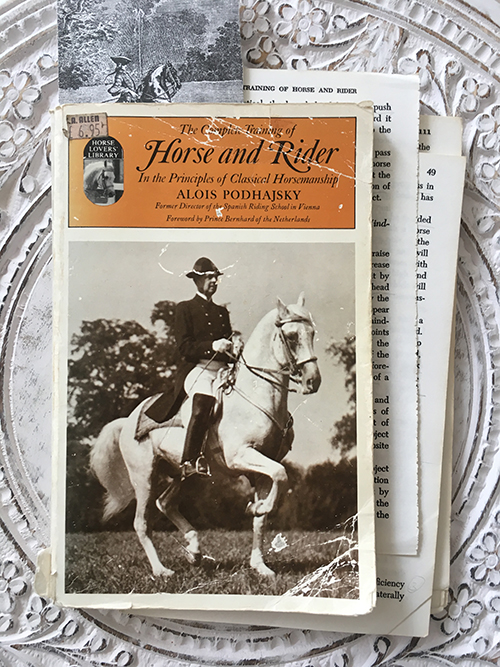

Andreas Hausberger – one of the Chief Riders at the Spanish School, but he also coaches some of the top competitive riders in the world. Image (c) Michael Rzepa
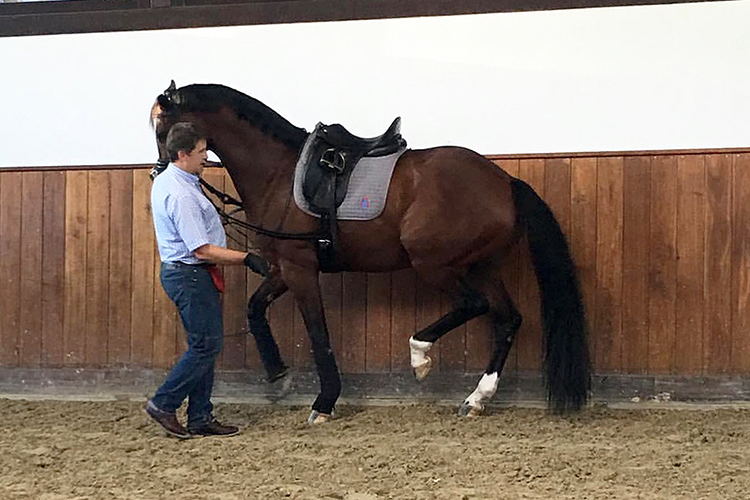
That’s Andreas out of uniform – but do you recognize the horse?
It’s Sönke Rothenberger’s star, Cosmo (photo – Barbara Schnell)
Many years on, I was fortunate to have an depth talk about horses with Andreas Hausberger, now a Chief Rider at the School.
Chief Rider Andreas Hausberger is one of the warmest, most knowledgeable, generous, funny and passionate people you will meet. It was an absolute privilege to spend so long chatting and I came away with a renewed love of the classical way, and it was a great reminder of the wonder and beauty that got me so enthralled in dressage at the very start.
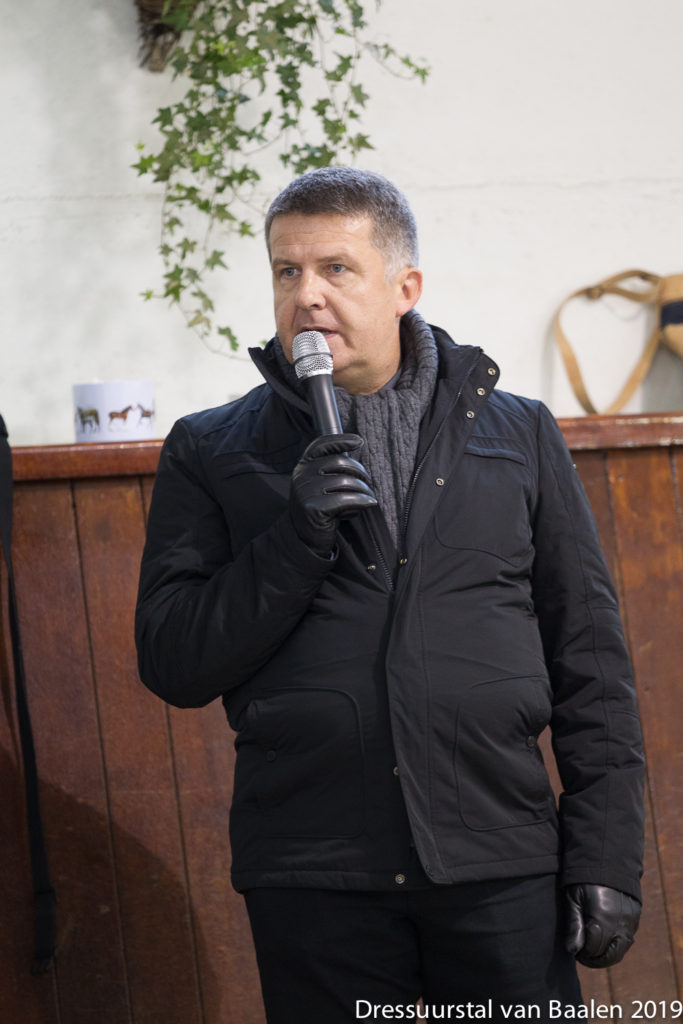
Andreas lecturing at the 2019 annual meeting of the International Dressage Trainers Club at the dressage stable van Baalen
Not only is Andreas a Chief Rider, training stallions at the School daily, but he is also helping some of the up-and-coming superstars of dressage sport.
Andreas, tell us a bit about your background. Your parents were horse breeders?
“My parents had a stud farm in lower Austria 120 km west of Vienna. That’s where we started to ride when I was seven. There were six of us kids, but my brother, who is a year younger and me became professional riders. He’s a showjumper.
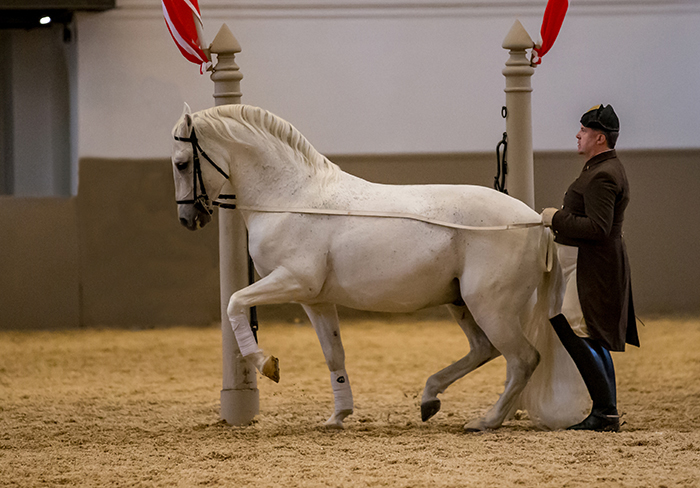 Andreas long reining in the School (Photo – Petra Kerschbaum)
Andreas long reining in the School (Photo – Petra Kerschbaum)
What drew you to the Spanish Riding School?
“As an Austrian and a horse lover, it came up when I was 13/14 years old that I wanted to become a professional rider. It was already my passion then. I thought an office job wasn’t for me and university, well I’d rather study horses, so I applied at the Spanish Riding School when I was 15. They didn’t take me, so I applied every year for three long years, and every year they didn’t take me. I didn’t even have the possibility to do a test ride. Every time there was an excuse or something wasn’t right, there was no space for another Eleve (apprentice). So at the age of 19 I gave up my dream of being a member of the School and I worked at a different stud farm.
“Suddenly the Spanish Riding School called my Mum in my absence and asked if I was still interested in becoming an Eleve. Luckily my Mum said yes. That was my luck! My Mum saved me!
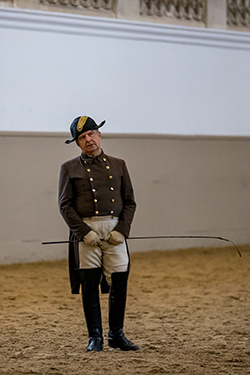 (Photo – Petra Kerschbaum)
(Photo – Petra Kerschbaum)
You’ve been there since 1984. What’s made you stay?
“To be an Eleve at the Spanish Riding School is blood, sweat and tears. It’s hard to enter but it’s even harder to stay here. The competition between all the Eleves, and they are all very good riders, it’s really the survival of the fittest. We keep the best of the best. When I made it to assistant rider, this was a HUGE step for me. But then it gets harder. You then get a four-year-old stallion to train up to the high school – up to Grand Prix. You have to do it all on your own. You are on the horse, nobody else. Everyone is helping you, the chief riders, all the other riders, you can come up with each and every question you have, but no one else is sitting on the horse. No one comes and says get off the horse and let me feel or try to get the changes for you. No. You are the trainer. You need to train the horse yourself to become a qualified rider of the Spanish Riding School. That’s what I did. Now I’m a chief rider.
“We are four chief riders and of course we share the responsibilities, and of course I am responsible for training horses and riders and so on, but we are four, thank god! I have eight horses at the moment as well.
Jessica Von Bredow-Werndl is another rider that Andreas helps…
Do you think there’s enough horsemanship taught outside of the School?
“With the people I teach, I would say absolutely. I’ve taught Jessica Von Bredow-Werndl for 15 years now and the Rothenberger family, Marlies Van Baalen and Matthias Bouten. Those are real horse people. They don’t just jump off the horse and hand it over to the groom. No, this is not the case. These are wonderful, world-class riders.
The tradition of the Spanish Riding School goes back 450 years. Do you think it’s still the same; the strong, oral tradition, the techniques?
” The success of the Spanish Riding School is its flexibility. Not in a negative way. We still follow de la Guérinière. He is the main figure at the School. This is so important. We don’t just teach the Eleves in practicing riding. They also have theory lessons which includes dressage history and includes all the big classical masters. One example, Baucher, he also has an influence at the School, but not much. But you can see part of his philosophy here. And then there’s Pluvinel and so on.
What part of Baucher’s philosophy do you take? I know de la Guérinière had his shoulder in amongst other things….
“Yes but he was much more than shoulder in. Everyone says he invented the shoulder in. I think he reintroduced it rather than invented it. People also say Pluvinel invented the pillars. He didn’t invent the pillars, he reintroduced them. That’s a big difference. But the loosening of the horse, of the necks and jaw, the warming up of the horse, that the horse is on the bit, this is more like Baucher. Guérinière was more focused on the heavy double bridles and bits, but he is still influential with his idea of progress from easier to more difficult, and this requires some steps in training.
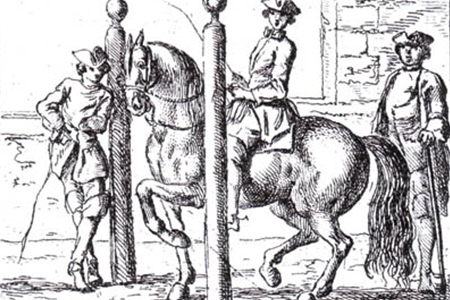
“The biggest change in the history of the Spanish Riding School was Podhajsky because he was influenced by the Germans. The most visible change he made was the hands. The rule elbow, fist and the horse’s mouth as one straight line. He introduced that to the School. Before that the riders had the hand way higher, and there was a broken line. All people don’t know that. It was a very, very big change. We have kept that up to today.
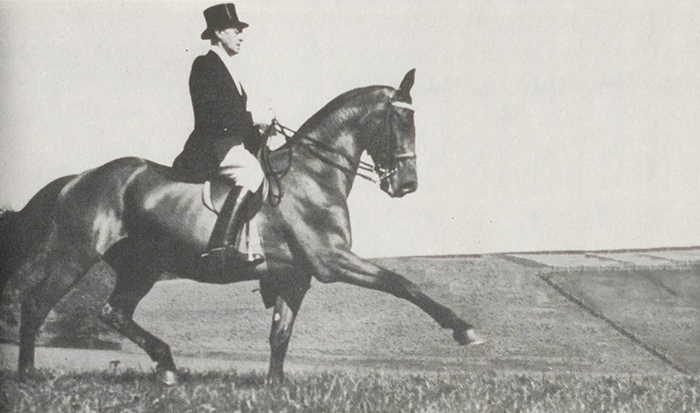
The biggest influence – Podhajsky
“I’m not sure you can say it’s a softer hand. It’s a different way of riding. The influence of the German riding masters is obvious and Podhajsky made that change.
Do you know what his reasons were for bringing that in?
“The Reitvorschrift (German Riding Regulations). It is mentioned in that, the straight line between the elbow, fist and mouth. Podhajsky was a member of the Nazi Party, that is why he became director of the Spanish Riding School, and he was a long time student of a German riding master in Germany before he was director here. He also introduced the one tempi changes to the Spanish Riding School. The first one tempi changes were in an Olympic dressage test in 1921. Podhajsky became the bronze medalist at the Olympics in 1936 in Berlin. He became Director in 1939 and introduced the changes to the School then. There was a big fight between him and the chief riders because the chief riders said the one tempis were not classical. It’s an artificial movement which is not based in nature and they were totally against it. But Podhajsky trained his stallions in it and we still train it and show it today because it needs a skilled rider. That’s the only reason why we show it, not because it’s natural.
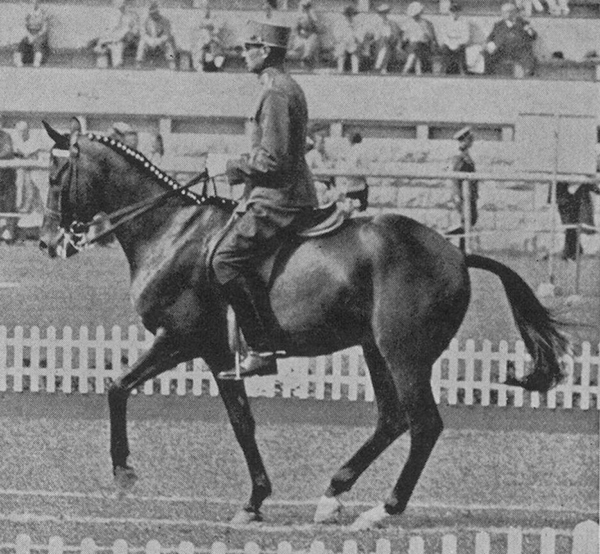
Podhajsky and Nero winning bronze at the 1936 Games
“The airs above the ground are only for the specialists, the horses who have a talent for it.”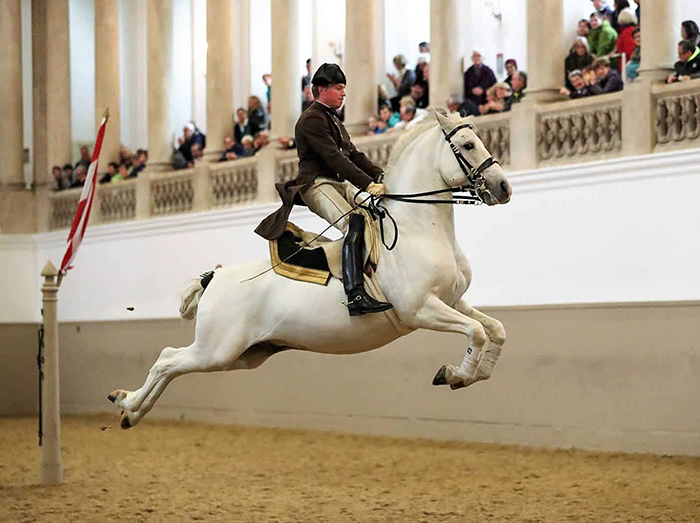 In modern sport, is there a real understanding of true and good collection and lightness without having that ultimate picture in your mind?
In modern sport, is there a real understanding of true and good collection and lightness without having that ultimate picture in your mind?
“Oh very much so. Look at someone like Jessie Werndl, who I’ve been helping for 15 years. She knows very well what lightness and collection is. Let me tell you, the basic is the seat, and she sits beautifully. 
Jessica – she sits beautifully
“We work together and I help her and if you can do it like this it’s a better outcome in the long term. And it really worked, but again Rebecca, it was not a straight way up. Sometimes it went downhill. One day you think, “Wow! I’ve got it!” and you’re close to tears because it felt so nice. The next day you think, “Oh my god! I’m sitting on a different horse!” and the feeling is gone and everything goes wrong. But in this situation, don’t overdo things, continue your work, be patient and be consistent. Have someone on the ground to say, this is right or that is wrong, and in the long term and then you’ll produce a wonderful horse; a wonderful, international horse which can do anything. I’m sure you are a rider yourself and understand.
Yes but I wish I could ride like Jessie!
“I would say most of the riders could if they had the right training. If they have perfect training. I’ve told Jessica, training doesn’t make perfect, perfect training makes perfect. That is a huge difference.
The seat is the base of everything?
“That is the main focus at the Spanish Riding School, that the position of the rider is correct and that the rider sits in balance. A balanced seat means that you don’t use the reins to hold you in balance. You have to give and to take without changing your seat. Even if the horse takes bigger strides or goes faster or slower, it doesn’t matter, you have to sit independently in balance. Therefore you have to do something. You have to school yourself on the horse, but not just on the horse, also on the ground, if you want to be world class. If you’re an average rider, you don’t need to do that, you can do whatever you want. But as a world class rider, you have to do exercises on the ground as well. That’s what we did and that’s what I do now with the Rothenberger sisters, Semmie and Sanneke and with Marlies Van Baalen and Matthias Bouten and so on. We work also on the seat, not just on the horse.
Another beautiful seat – Matthais Bouten
What are some examples of working on and off the horse?
Jessica brought out her rider’s training program, Dressurfit (also now in English) which is perfect advice for what you can do on the ground with no horse. That is one of the best things she could bring out. I really recommend it for each and every rider.
And in the saddle? No stirrups?
Come on! No stirrups, no reins and vaulting exercises in full gear: boots, jacket.
Come on! Rebecca! Hey! (I can hear Andreas smiling through the phone). Mounting the horse with no stirrups. This is obligatory at the Spanish Riding School. If you cannot do it, you don’t get a lunge lesson. You better prepare yourself that you’re able to do that!
What if your horse is 18hh and you’re only 5’4”?
(Now Andreas is wildly laughing). Well then we will find a way! The Lippizaner is not so big!
I’ll have to practice that then. I’ll find a Shetland!
The riders like Jessie and the Rothenbergers, obviously get you to train the in hand work and piaffe/passage. Is that your main focus?
“Mainly on piaffe, passage and canter pirouettes…and seat and position of the rider. One of my stronger points is to work with young people and kids. Jessica was early 20s when we started. Semmie Rothenberger is multiple young European Champion and Sanneke is also very successful. Also I’ve worked with Raphael Netz, the number one U25 rider at the moment who is based at the Werndls. I don’t even have an older rider now. I think Marlies is the oldest at 32.
Why do you do you stick with the younger ones?
“I tell you why. Those young riders are like rough diamonds. You can cut and polish them and make them beautiful. You can form those riders much easier than an older rider who has this and that problem. It is much, much harder to get rid of a problem than learn it the right way from the start.
When do you see piaffe and passage go wrong? Generally?
“When there is no patience. Patience is so important. People ask when should I start work in hand and piaffe? I say start very early like at the age of five and then take years to establish the piaffe. Years! Don’t do piaffe or work in hand once a month. Do it everyday from five years old, but not too long. Maybe just one long side of the arena and finish. Don’t overdo it. Concentrate a lot on the basics, like the horse is straight, he doesn’t run through the half halts, that he has a correct reaction on the whip, that the horse doesn’t fear the whip, because we don’t want to create a fear on the spot. The horse should not be afraid of piaffe. It should be a totally relaxed, but of course it is a collected and swinging exercise.
 Piaffe with Podhajsky
Piaffe with Podhajsky
“Also the same applies to the rider. Many, many trainers I see put too much pressure on a horse and then the horse becomes uncontrollable for a young rider and then the young riders fear the exercise and then it becomes a vicious circle. My part then is to take them out of this vicious circle and tell them, listen, we don’t do too much pressure, we do what is very correct. The young rider focuses a lot on the seat. Most of the time I do put the young rider on top of an experienced horse in piaffe. I do the work with the cavesson and the side reins. The rider just sits on the horse and feels what is going on. He doesn’t touch the reins but he does have stirrups. Then the young rider isn’t fearful anymore.
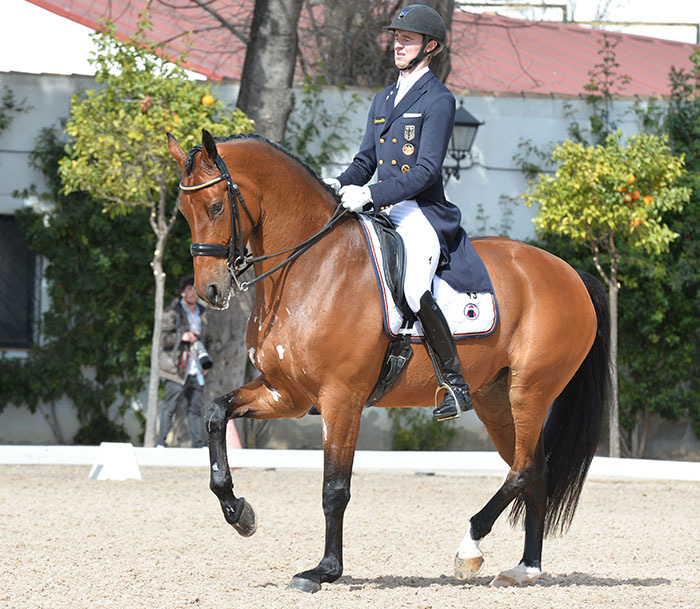
Sönke and Cosmo – no fear of piaffe
“That’s how it worked with Jessica. That’s how it worked with Sönke. I helped him to quality for the Rio Olympics. Now they are all trying to qualify for Tokyo, including Marlies.
You always teach piaffe before passage?
“Always. That is crucial, because I see lots of piaffe which is not really piaffe. It is passage with less ground cover and that is wrong. So wrong. And you don’t score with that. The judges see that.
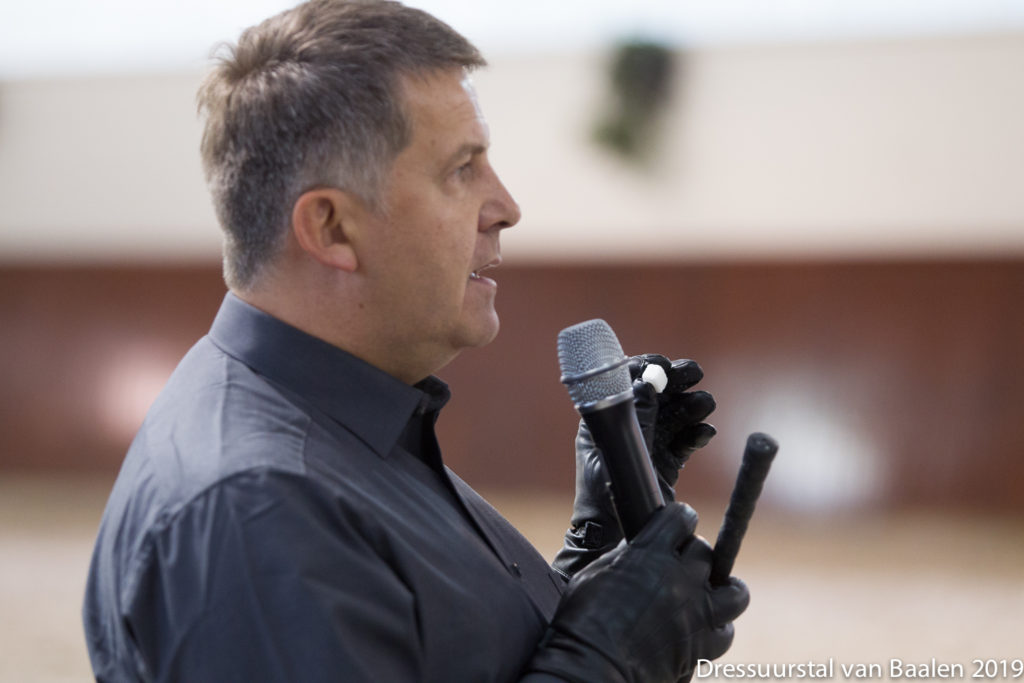
“Good piaffe depends on the horse, it depends on the training, sometimes the horse is pulled together too much. You have to watch the whole horse. You have to watch the body language of the horse and focus on the neck of the horse, the nose line is so important, what the top line looks like. Is the top line uptight? Is the horse too deep out of the wither? Does he need to come up more? Does the nose need to come forward more? It all depends. Don’t just watch the hindlegs – are they active enough and underneath, you have to also look at the top line. Along with all that, you have to also look at what the rider does. There is so much to focus on. If you do it correctly, you’ll have a piaffe like Dalera. To me this is perfect piaffe.
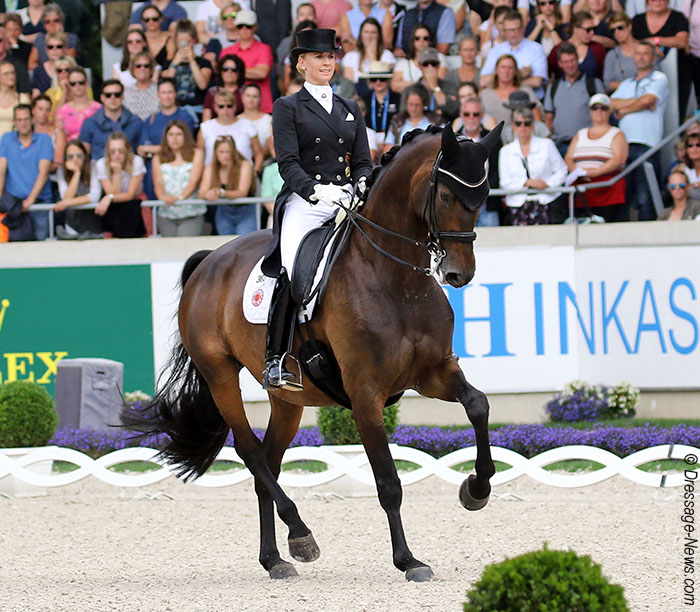
Perfect Piaffe – Jessica and Dalera – photo Kenneth Braddick dressage-news
“One of the very important philosophies at the Spanish Riding School is that the horse needs to have talent for what he is used for, so there is no force.
“We don’t force a piaffe or passage or pirouette or the airs above the ground. It is the same with sport horses. If the horse is not talented, you can’t force it. But you can ruin a talented horse with wrong training.
Story continues below the advertisement
Do you think dressage has changed?
“Let me tell you, we do have two training systems. One is the classical art of riding as a training system. The other is rollkur as a training system. Years ago when the big-named Dutch riders came up, everyone thought the rollkur was the method to train a proper sport horse. Now, it goes in the other direction. All these young riders, they go back to the classical way of training a horse because this is the horse friendlier and the proven training method. That’s why Jessica says this is the training system for her. Sönke said, this is the training method for me. Cosmo was in the Netherlands for training before I took him over. The Rothenberger family said that was not the training system for them.
With a horse like Cosmo, was it hard to change the training system?
- Very easy. He understood what we were doing immediately. We didn’t start from the beginning. I went backwards. Relaxed, little pressure, let the horse do it on his own, didn’t force it. Before Rio Cosmo was eight-years old. I helped them with piaffe. We started to do it in hand with baby strides. The focus was on the relaxation, that the horse trusted the hand. That was the main focus. Then everything went smoothly. The horse trusted me, I trusted the horse, Sönke trusted the horse, the horse trusted Sönke, so everything came together.
Cosmo – the horse trusts Sönke…
How long did that process take?
The Olympics were in September and I started with Sönke in January. Let me say, the parents of Sönke are world class Olympic riders. Of course then, when I was not there, the training was perfect. They trusted me and we built a nice team and then we made it. It’s also an outstanding horse.
What’s Cosmo like to work with?
Oh he’s a personality. So is Dalera. I don’t walk up to the horse and say I am the alpha male and you have to do what I tell you. If I walk up to those horses like I am the alpha and you are my slave, NO, it doesn’t work. If you don’t see the horse as a partner, you are wrong. You’re in the wrong place. That is one of the main parts of classical riding, that the horse does all the exercises voluntarily.
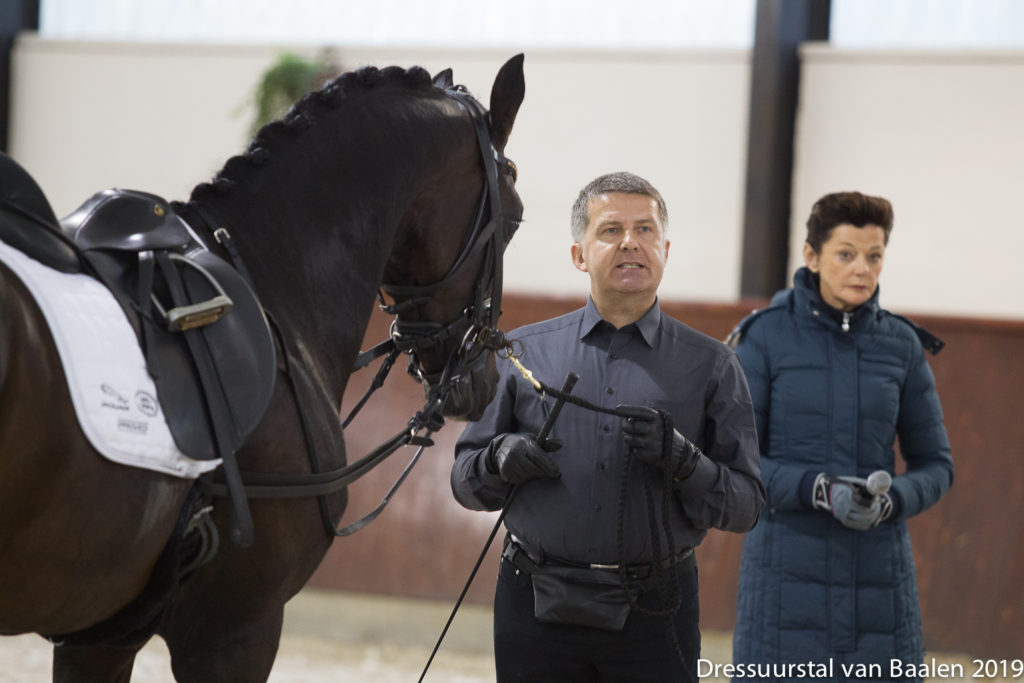
I grew up in the system of the Spanish Riding School. I don’t even know how to do it differently. But anyway it works perfectly. People always say they wished they’d worked in this system with me earlier. I’m not a witch, or a magician. I do it at the Spanish Riding School and I do it with the sport horses and most of the time it works. I always say, each and every horse can do piaffe, but not each and every horse can do a piaffe for 10. That is talent and that is what genes and nature gives the horse.
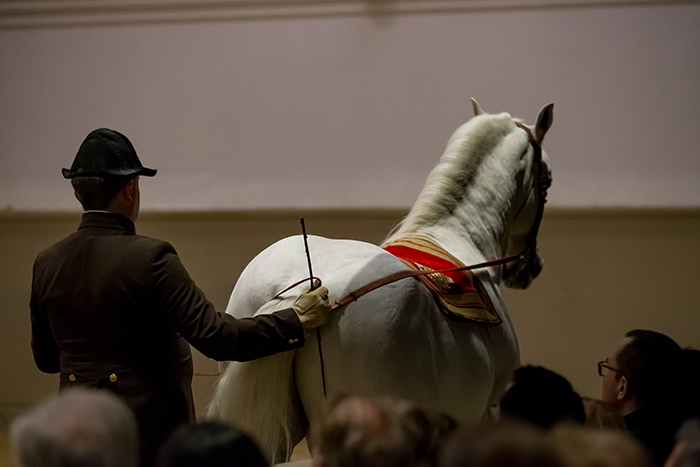 (Photo – Petra Kerschbaum)
(Photo – Petra Kerschbaum)
Most people don’t do work in hand. It’s extremely hard to do. If you don’t do it properly, you ruin the horse. The horse will not learn piaffe, only fear on the spot. Some do tricks, but instead you always must start with basics. Do it properly, start early, give the horse enough time to grow into the exercise.
Do you think some horses are pushed too much in the modern sport?
No, I think they start too late – then they are pushed too fast. Usually you do the small tour – Prix St Georges and Inter 1, and they are successful and then they go to Inter 2 and Grand Prix, and they need to do piaffe. That is too late. They should start piaffe much earlier. Then you have a couple of years to establish a correct exercise. It’s the same with pirouettes. You have to start early and then give the horse more time to grow to do these highly collected exercises.
Do you think the nine-year-olds doing Grand Prix is too young?
No it’s not too young. But again, you need to watch the horse. The horse will tell you if it’s too early and the judge can clearly tell if it’s too early.
I saw you working with two whips, one on the front legs, one on the back. Your timing is impeccable…
But that helps the horse so much! It becomes then so easy for the horse to understand what the rider wants. That takes pressure off the horse and pressure off the rider. The feeling gets much better. As a rider, you have to school your feeling. It especially helps the young riders so much to understand the exercise. You know who introduced the two sticks to the Riding School? It was Chief Rider Wahl, the trainer of Christine Stückelberger, in 1955.
Christine Stückelberger and the mighty Granat, trained by Georg Wahl, a Chief Rider at the Spanish School
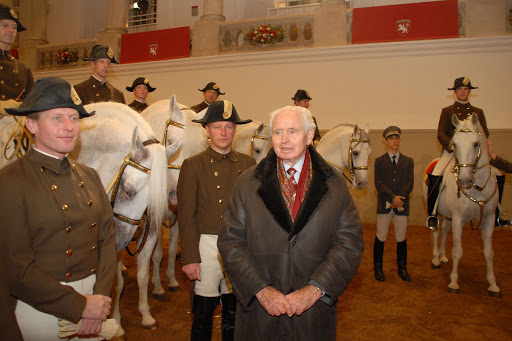 Georg Wahl – honoured at the Spanish School in 2013 .
Georg Wahl – honoured at the Spanish School in 2013 .
“I always say to the young people… read. Take the time to study the classical art of riding. But I don’t know any rider who became a good rider just by reading, it is a base, and you need that base. You need that theory, then you learn to ride on the horse.
“For each and every exercise I watch first the rider. When a rider comes up to me in the first lesson and says, “Andreas, I have problems with this or problems with that.” I always say, “Show me. Show me what you do.” I watch and then we can talk about it.
“If the riders just say the horse is running through my half halts or not listening to my outside rein or inside leg or whatever, I need to see the horse first and I watch the rider. Then I start changing something with the rider’s seat or the rider’s hand position or leg position or where the neck of the horse is and so on.
“We start there and then everything starts becoming natural and easy. We don’t do tricks. I’m not a magician! With the half halt, maybe we talk about the wrist or the ring finger or squeeze out a sponge, of course you need to close your legs, close up the horse, watch the top line, check the nose line of the horse, you need to control the downward speed, but also the upward speed because there is no collection without going forward. Everything is then easier to understand. It works all the time.
Story continues below the advertisement
“I focus a lot on the seat of the rider. The upper body must not be forward or backwards. You must sit in balance. When you watch some warm up arenas, sometime you think if you cut both reins, the rider would fall off the horse backwards. Because the rider uses the reins so much to hold himself in position, that cannot be right for the horse.
“This is the main focus: seat bones and which seat bones to use when. For example, in the half pass, you sit on the inside seat bone. However I don’t think the rider should see it all too technical because then of course the rider thinks, now I have to feel my seat bone and I don’t feel the bloody thing! What do I do? So, the brain does too much and the rider loses everything. So, I tell most riders not to view it so technically. You sit on the inside seat bone in the half pass if the outside leg goes one hand length further back. That automatically lifts the outside seat bone. Then you will sit correctly. But that is when you are sitting evenly in the saddle.
“So it is essential that you have the correct seat, not twisted hips or twisted shoulders. Everything is very, very important in this whole picture.
Like in canter the same. Because in the book it says you have to sit on the inside seat bone in the canter. It’s fine and totally correct and it shouldn’t be missed, but don’t see it too technical or panic when you don’t feel it. When your outside leg goes further back, you automatically lift the outside seat bone… if you are sitting evenly in the saddle. You must have an even, balanced seat.
Jessica and Dalera at the Euros in Rotterdam
“Well Jessica and all these top riders, they do have mental coaches and fitness coaches and specialists in that way. I do riding in general. It’s not just the pirouettes and piaffe/ passage, I also help with flying changes and half passes but the main focus is those highly collected exercises. If you lose points in those movements, you really lose a lot with six judges.
So is the Spanish Riding School still relevant today? You’d have to say yes…
“I have so many requests from sport riders now wanting me to come and help them and you know, my time is limited. I have to be in Vienna on Saturday and Sunday for the performances and Monday is my only day off and the only possibility to travel and go and help people. But my main focus is the Spanish Riding School, the performances and the training of my stallions. That is my aim, my love. Oh my god! I could not even imagine not doing what I do.
Every horse is a journey, every horse offers a different challenge…
“And that’s what makes it so nice. Even if you ride for years, I’m now 55 and have ridden my whole life, but it’s still challenging. If you take on a young stallion, you have to start from scratch and move up with the horse and to make a perfect high school horse. It gives me goosebumps; doing what I love my whole life.
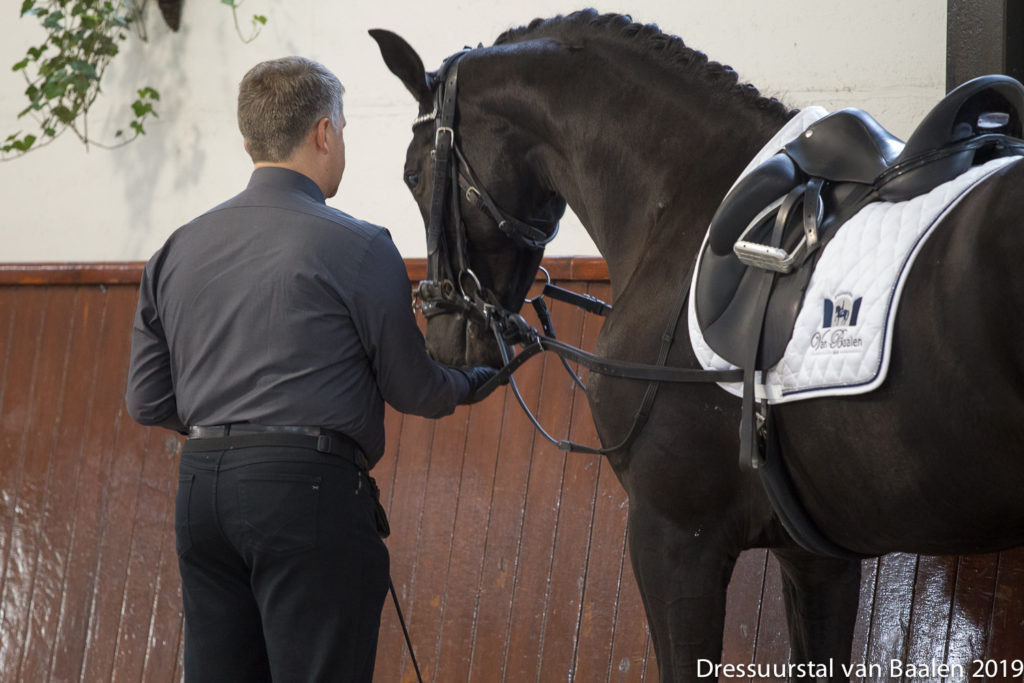
Do you need a certain mental make up to be a top rider?
“The horse makes me what I am. As a young rider, sometimes you think I have to do it now, and not a second later and you drive against a wall. If you are a sensitive rider you think, “Oh that’s not right. What I’m doing here?”, even if you want it now. With each and every young rider, sometimes it happens, that you try it for weeks and it doesn’t come right. Stay patient, stay focused, focus on the basics and then it will come. The exercise will be there. Sooner or later. Then each and every exercise is a result of preparation. If you don’t prepare the horse correctly, you will not have a proper exercise.
Do riders need to develop the understanding of the purpose of each exercise, and the progression of the exercises?
“I have it a lot with the young riders now. Semmie Rothenberger, she kept telling me, “Andreas, since we did piaffe with my horse, the horse feels much nicer than before. It’s more uphill, more together.” It has a big influence on the rideability of the horse. The emphasis though is on doing the exercises properly. Then they will change the horse. I put Semmie on the horse when I do piaffe in hand, with no reins, not aiding the horse but just sitting there and feeling what’s going on in piaffe. How does it feel when the haunches are active and the hindlegs are taking weight, the back is swinging, the horse is light in front and coming up, growing from the wither?
“The philosophy of classical riding is not just to teach the exercise and present the exercise in front of judges, but to help the horse to muscle up properly, to make it more beautiful and to keep it healthy as long as possible.
“It’s the focus here at the Spanish Riding School and when I work with top class sports riders, I have the same aim. To do these most difficult exercises for years without getting harmed. This is important. The side effect is that it is a very correct exercise that scores beautifully at competition.
When horses keep getting injured, you have to question the training don’t you?
It depends. Sometimes it is the training, you’re totally right, but it can happen even with perfect training. Sometimes we get injuries at the Spanish Riding School, but not very often at all. And it can also happen with sport horses, but with the horses I work with, it’s very correct training, very collected but very relaxed training with breaks in between letting the reins be chewed out of the hand, using the light seat in canter, always playful and growing into the exercise. That’s also my philosophy, horses should go into paddocks, be allowed to go out and be horses, not machines. They should spend at least a couple of hours out on the grass before or after training, depending on the horse.
You look at saddle and bits and other products. There’s always a new one on the market. Do you think it’s over done or good that technology is progressing things or is a soft double jointed snaffle is as good as it gets?
“Thank god we have those inventions. It’s very important because if things hadn’t changed over the last couple of hundred years, we’d still be riding with those big curbs on young horses. Torture instruments. If we didn’t think what is nicer for the horse, we’d still have them. I really agree with modern equipment that is for the welfare of the horse. Again, I am totally against tricks, whatever they put on horses that they think will help them ride better. It won’t. You have to sit properly, of course get a perfect saddle for horse and rider, perfect bridle, just to make it easier for the horse to do his job.
Our talk finished with Andreas emphasising……
“The classical art of riding is to work each and every muscle of the horse’s body, to enable the horse to do the most difficult exercises for a long period of time, meaning years, without getting hurt. Then it is a perfect understanding of why we ride and work these beautiful creatures.
“My aim is not to present a perfect piaffe in front of six judges in the test ring, but to make the horse more beautiful and keep it healthy as long as possible.
“Chief Riders from the Spanish Riding School have had a long tradition of helping top sports riders: Alois Podhajsky was himself an Olympic medalist, Georg Wahl helped Christine Stückelberger and the formidable Granat, Franz “Rocky” Rochowansky helped British Olympian Vicki Thompson and Ernst Hoyos is a constant by the side of American Olympic medalist Lisa Wilcox. It’s good to know the tradition still continues, that the up and coming superstar young riders are turning to the masters of the tried-and-true classical method to further their knowledge and progression. The Spanish Riding School is perhaps their Shambhala as well.

Thinking of breeding your own dressage star in Australia? The latest, and best producing stallions are available from www.ihb.com.au
Stallions like Birmingham, combining the bloodlines of Jazz, De Niro, Fidermark, and Sandro Hit


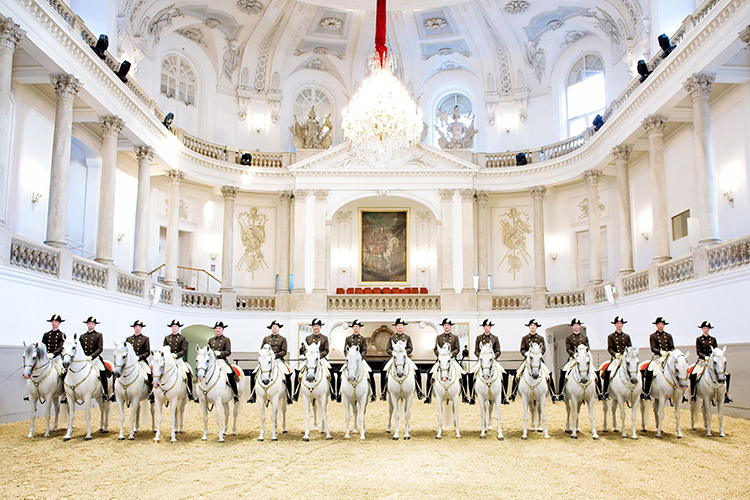
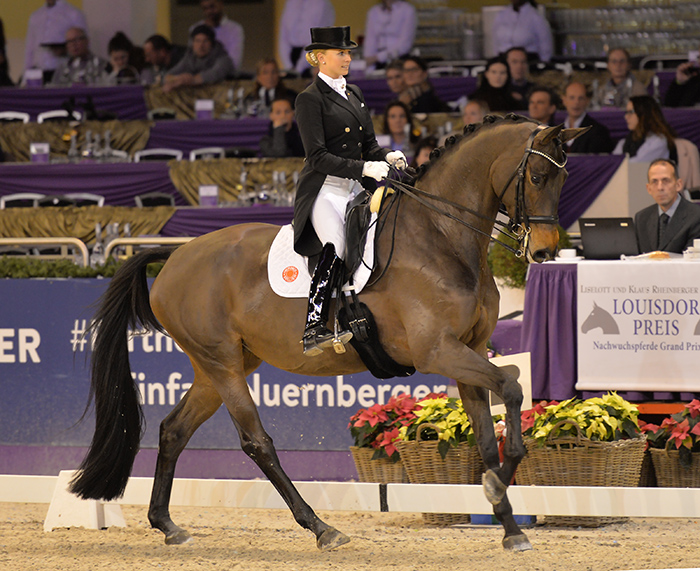
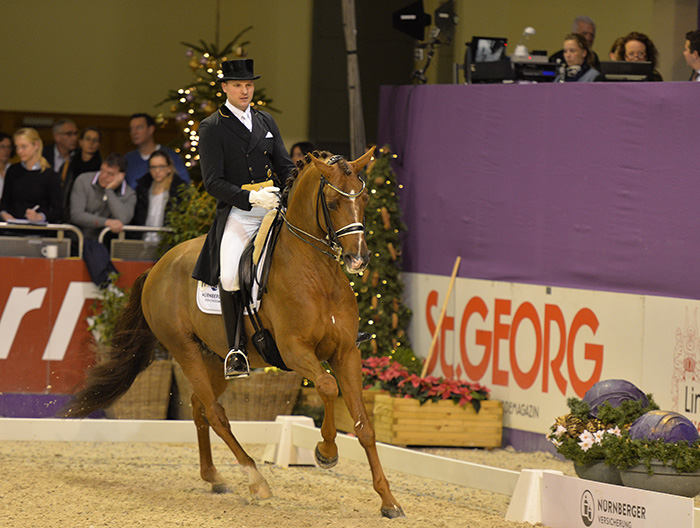
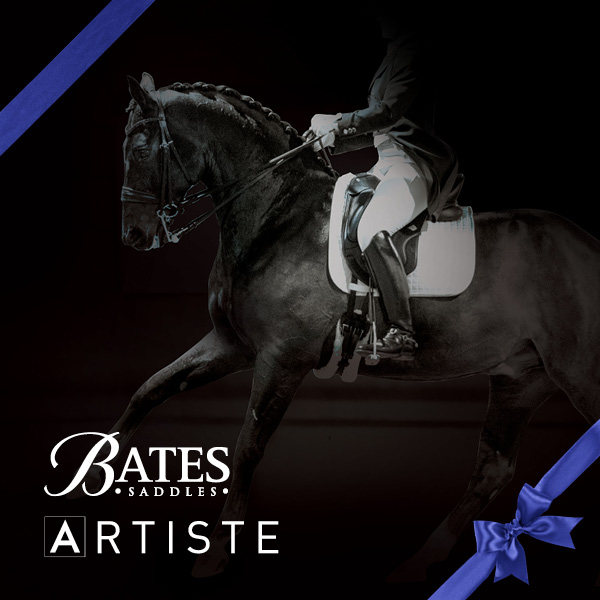
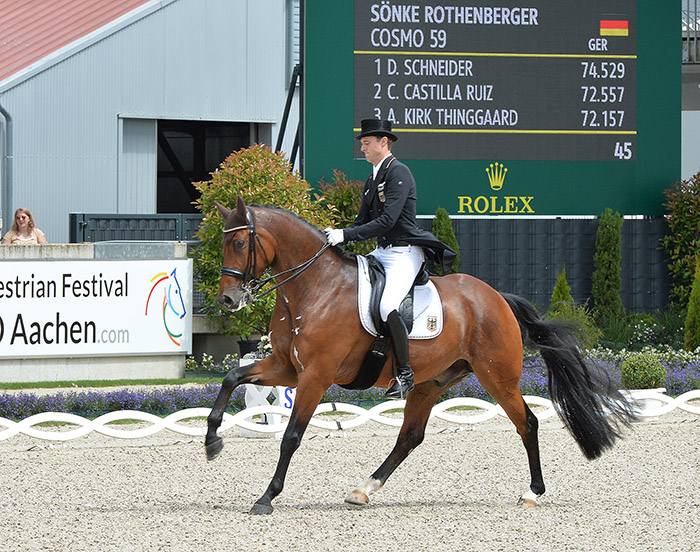
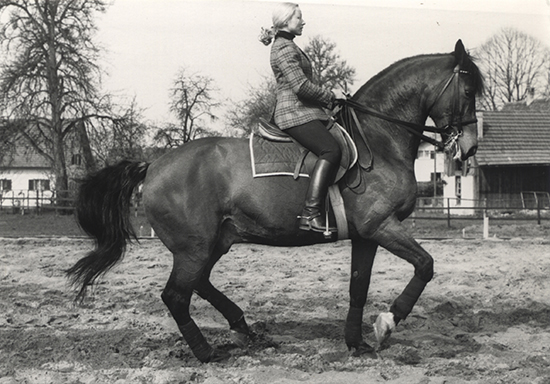
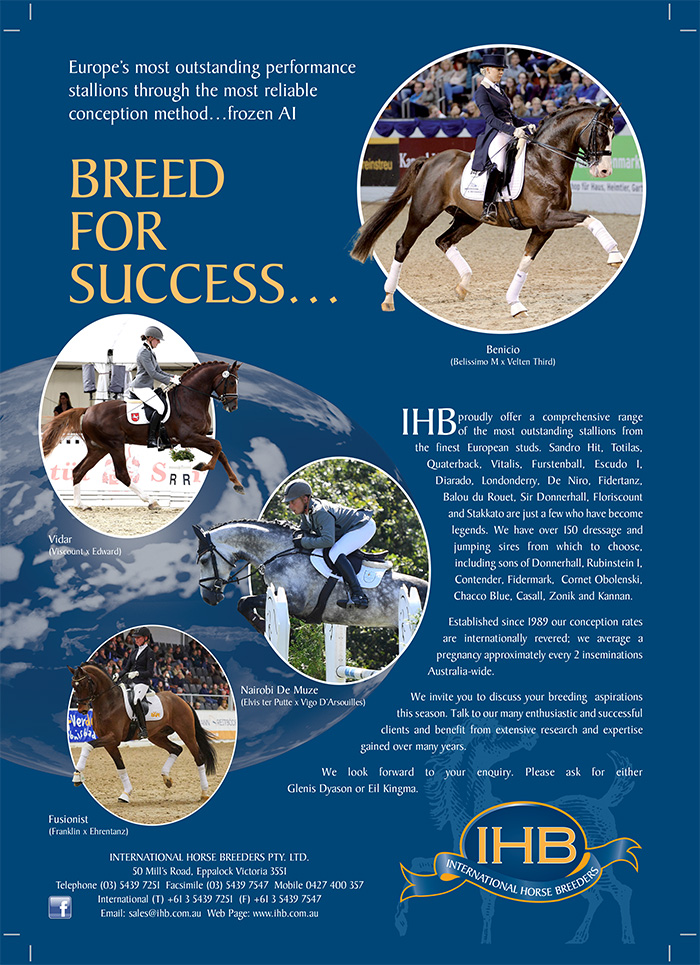
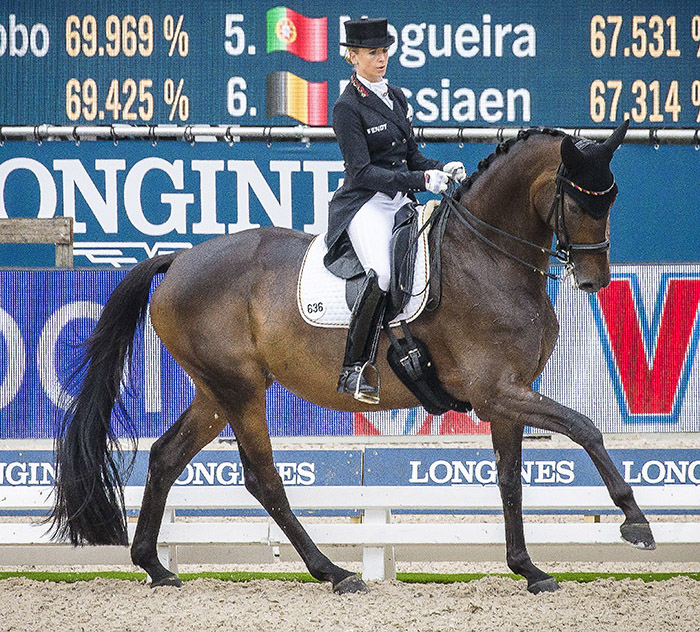
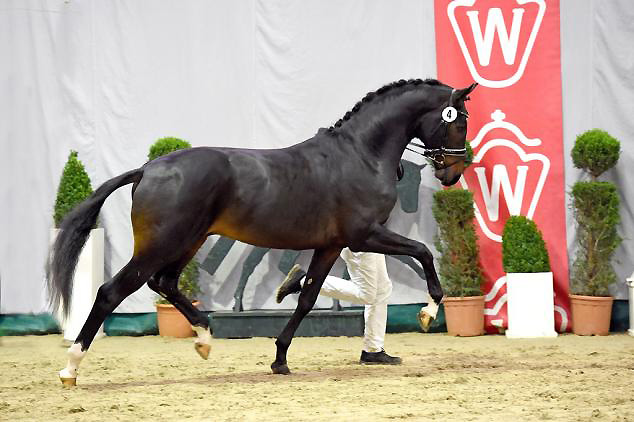
fabulous read. thank you Andreas!
A wonderful article. Thank you Herr Hausberger
Such an insightful article.
Wonderful read. Thank you.
ondanks mijn leeftijd weer een bevestiging van hoe het juist moet theorie praktijk maar vooral zit en gevoel onder juiste begeleiding
What an interesting article. I was able to travel to Vienna in 1981 to see the Spanish Riding School but unfortunately I was not able to see a performance. I did get to go into the stables.
Thank you for sharing this interview. I have met Andreas Hausberger and follow his training.
Such a heartening and inspirational article. I am so glad you are working with the lucky sports riders you are, and that the tradition and devotion of the SRS continues to lead the way for all real horsewomen and men.
Another must read for all aspiring riders
i enjoyed reading this.
Thank you. So informative and clear. Inspiring.
A very enjoyable read and so good to have the emphasis on slow correct training developing to suit the individual horse’s talents.
Wonderful that there are such clearly insightful souls training beautiful horses. So uplifting to read, thank you
Thank you for the opportunity to have a glimpse into the world of dressage & the relationship between horse & rider.
Absolutely fantastic. Something all aspiring riders should read and study
Thank you